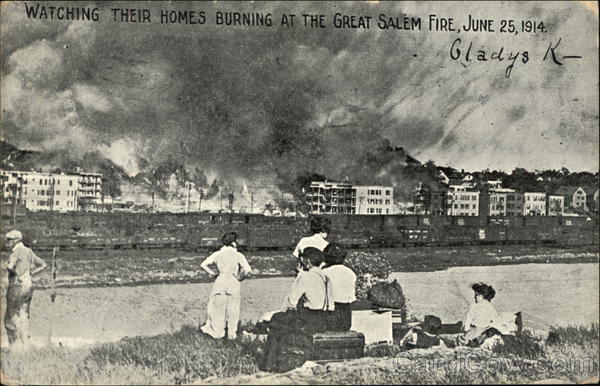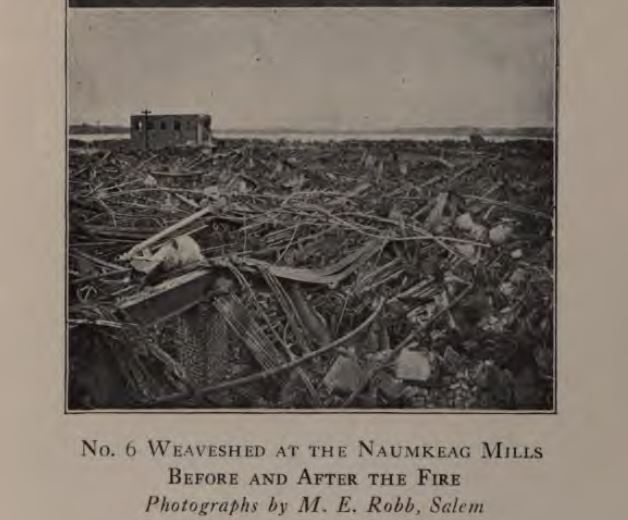The Great Salem Fire of 1914 was a large fire that took place in Salem, Massachusetts on June 25, 1914. The fire killed three people and injured 60 people.
In addition, the fire left 18,000 people homeless and 10,000 people without jobs after it burned 253 acres and destroyed 1,376 buildings in the small town. The damage caused a financial loss of about $15 million and insurance policies paid $11.744 million.
The fire took place on a hot, dry windy day during a drought. It began at 1:37pm at the Korn Leather Company factory on Boston Street.
At the start of the fire there were a series of explosions mostly likely caused by the combustion of the large amount of acetone, amalacitate, alcohol and celluloid stored on the premises
A state official was later quoted in the two local papers explaining how and where the fire started, according to Salem firefighter Arthur B. Jones in his book The Great Salem Fire:
“A high state official is quoted in two papers, dated July 10 and July 11 as saying at the Chief’s Club in Boston, July 9th: ‘In the Korn factory they were manufacturing what is known as the tip finish for patent leather, a compound of inflammable materials. The fire started in a shed which opened by a wooden door into a room on the street floor. Two boards of the door were missing. The shed was filled with a quantity of of cheap sheep skins, and there were three parts of barrels filled with the highly inflammable substance I have mentioned. How the flames originated I do not know, but I do know that once the fire started it spread to the barrels and the sheep skins, and swept up the open elevator well to the third floor, where there was more of the inflammable compound and a saturated floor’” (Jones 35-36.)
It is believed that the fire was probably started by sunlight coming in through the window and igniting some strips of celluloid on the floor and if the building had been equipped with a sprinkler system it would have probably been saved since there were no combustible materials present that couldn’t be extinguished with water.
The fire was discovered on the first floor of the factory by a worker named Reuben Salkovitch. Salkovitch stated that the flames burst through the door of the shed and spread so quickly that he had to run for his life while the flames scorched his face and clothes as he ran.
The other factory workers panicked and fled and one employee, Charles Lee, jumped from the third story window, after being burned on the hands, and suffered broken bones in both feet.
The Quinn Block to the east quickly caught fire as did the Creedon factories to the west before the fire crossed Proctor Street, caught the Cunney factory on fire and burned half of the brick block nearby.
The flames continued down Boston Street and caught the Keefe factory on fire as well as a property on the corner of Federal and Boston Streets. Soon the remaining factories on Boston Street were in flames.
The Salem fire department was quickly overwhelmed by the rapidly spreading fire and called on the Peabody fire department for help at 1:45pm, the Beverly fire department at 1:50pm, the Marblehead fire department shortly after, Lynn at 1:53pm, Swampscott at 1:58pm, Boston at 2:25pm and Chelsea at 2:55pm.
Sometime in the late afternoon the Hingham fire department also heard about the fire and sent Engine 2 to help.
In addition to the fire departments, a call was also put out to the National Guard at 2:31pm. Company “H” of the 8th Massachusetts Infantry Regiment and the Second Corps of Cadets happened to be drilling in nearby Newbury and arrived shortly after to assist in first aid work (Boehm 2014.)
By this time the fire had spread to Fowler Street where it consumed the school and local houses and five houses were dynamited by the fire department to stop the spread.
On Essex Street, two houses were dynamited and everything above North and South Pine caught fire. Highland Avenue and the high school there caught fire and the bridge there was destroyed. The wind spread the fire to Leach Street where six houses burned.
As the fire continued to spread, more fire departments were called including Wakefield at 3:08pm, Danvers at 3:15pm, Newburyport at 3:30pm, Reading at 4pm, Stoneham at 4:10pm, Revere at 4:24pm, Lawrence at 4:40pm, Malden at 4:55pm, Gloucester around 5pm, Manchester at 5:07pm and Medford at 5:10pm.
Between 3pm and 5pm, upper Broad Street, Hathorne Street, Orne Square, Winthrop Street, Endicott, Downing, Margin, Prescott, and Cedar Streets caught fire.
After 6pm, the fire spread to Fairfield Street, part of Gardner Street, Cabot Street, Hancock Street, Roslyn Street, Canal Street and Hazel Street.
Everything on Lafayette Street was also soon consumed and the 100 children from the nearby City Orphan Asylum of Gray Sister of Charity on Lafayette Street were quickly evacuated by the 25 nuns who ran the orphanage just before the building burned to the ground.
At 6:45pm, the last house on Summer Street caught fire and Mount Vernon Street and High Street were on fire by dusk. More houses were dynamited on Mount Vernon Street to stop the spread as were three houses on Roslyn Street and a house on the Hawthorne Block.
The fire continued down Ropes Street, where it burned down the engine house, St. Joseph’s Church, the parochial school, Goodell’s garage and other buildings. It then caught Salem Point on fire and spread down Lagrange Street around 7pm and then set the Naumkeag Mills on fire.
At around 7:30pm, the Somerville fire department arrived after hearing about the fire from their fire chief.
Around 8pm, the Winchester fire department arrived and got to work fighting the fire in south Salem near the orphanage. Fire engines from Ipswich, Wenhan and other towns also arrived and fought the fire in various parts of the town.
Fire fighters managed to hold off the fire at the Salem Laundry building on Lafayette Street but the nearby Hamilton and Balcomb buildings and the Pitman and Brown buildings were destroyed.
Union Street, Pickering’s coal pile at Pickering wharf and the nearby wharves caught fire but a three-story brick building at Lane’s wharf managed to slow the spread and the fire fighters were able to get the fire under control by 3am, saving the nearby Derby wharf.
The following morning, a call was put out for firefighters to relieve the ones who had been working all night and the Cambridge fire department responded around 9am and relieved the firefighter trying to fight Pickering’s smoldering coal pile near the wharf.
The smoldering fire attracted a lot of attention from the public and it is estimated that nearly one million people flooded the town and came to see the aftermath the following day.
The National Guard issued a number of general orders instituting semi-martial law in the town and ordered civilians not enter the ruins and threatened to arrest anyone who didn’t comply. Orders were also given to the troops to shoot all looters on sight.
On Friday morning, June 26, 1,700 Massachusetts National Guard Soldiers arrived in Salem to assist in the relief effort. This included 12 companies from the Eighth Massachusetts Infantry Regiment; four companies of the Second Corps of Cadets from Salem, and seven companies of the Ninth Massachusetts Infantry Regiment (Boehm 2014.)
Tent cities serving as makeshift housing for the now homeless fire victims popped up all over Salem’s public spaces, such as on Salem Common, Salem Willows, Forest River Park and even the Broad Street Cemetery.
The Salem Armory became the relief headquarters where these refugees were fed. On the first day, Friday June 26, 2,500 people were fed. On June 28, 6,045 rations were issued, June 29, 6,038 rations were issued and on June 30, 6,065 rations were issued. The total cost of feeding the refugees was about $2,200 per day and about $50,000 in total.
The rations were necessary not only because people had lost their homes and all their food and supplies but because the local stores had completely run out of food and water, especially after the influx of tourists coming to the town to view the damage.
The National Guard was relieved of its duty at 8pm on July 7, after 12 days of duty, when the task of feeding the refugees was taken over by the city’s general committee, led by Colonel Spencer.
The fire continued to smolder though in some parts of town and even three weeks later the coal pile at Pickering’s coal plant was still burning.
The rebuilding process began after the city assessed the damaged. By February of 1915, a total of 353 building permits were issued in the burned district.
Sources:
Jones, Arthur B. The Great Salem Fire. Gorham Press, 1914.
“A New Pickering Plant from Ashes of the Old.” The Black Diamond, Volume 54, No. 1, 1915, pp: 166-167
“Great Salem Fire of 1914 Burns Half of the City Out of Their Homes.” New England Historical Society, newenglandhistoricalsociety.com/flashback-photo-the-great-salem-fire-of-1914/Boehm, Bill. “A Firestorm Where the Guard Began: Great Salem Fire of 1914.” National Guard, 25 June. 2014, nationalguard.mil/News/Article/575989/historians-corner-a-firestorm-where-the-guard-began-great-salem-fire-of-1914/




